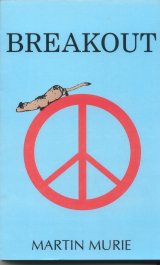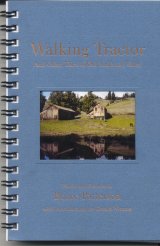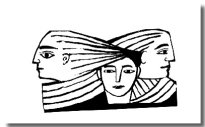by Gilles d'Aymery
Book Review



Books reviewed in this article:
Murie, Martin: Breakout, Packrat Books, North Bangor, New York, 2005 - ISBN 0-9702922-3-6, 306 pages, $15.00 (paperback)
Patterson, Bruce: Walking Tractor, And Other Tales of Old Anderson Valley, 4mules Productions, Boonville, California, January 2006 - No ISBN, 219 pages with some 25 color photographs, $19.95 (paperback)
Gerald, John Bart: river with lights, Poems with drawings by Julie Maas, Gerald and Maas Editions, Ottawa, Ontario, Canada, 2005 - ISBN 0-9731090-1-7, 68 pages, $20 (paperback)
"Every day that we wake up is a good day. Every breath that we take is filled with hope for a better day. Every word that we speak is a chance to change what is bad into something good. We aren't slaves... This nation is at least a potential democracy. We need to wake up from this walking nightmare and realize that the sun is shining..."
—Walter Mosley, What Next: A Memoir Toward World Peace (Black Classic Press, 2003)
(Swans - December 4, 2006) The holiday season is upon us. A time in the northern hemisphere when the snow graces our land, or the rain is falling, and we gather around the wood stove or the fireplace to warm our bones dry away from the outside cold. Soon, we all -- at least the happy few among the multitude of unfortunate, wretched masses around the world -- will unwrap the presents that friends and family bought with loving care or out of tradition and conformity. In this household we tend to not conform. Yet there will be some flowers and a couple of gifts -- books and music -- and always a simple postcard reaffirming (and reassuring each other) of our reciprocal affection and love.
It is that time of the year; the moment you choose the gifts, the moment you give. Here are three recommendations. I'm sure there must be a fourth and fifth one, etc., but you cannot go wrong with any one of these (or all) three books. These authors stand for people who day in and day out offer a perspective that makes one want to wake up in the morning with a smile and pursue the modest work so many of us do, plugging away humbly, through many disappointments and discouragements, with tiny and sparse victories in between, on the long battle for peace and justice.
Each book is quite different -- a novel, a series of essays about country life, and poems adorned with Julie Maas's superb drawings -- but their authors have much in common, as though an invisible thread connects them on their respective path along the famed road less traveled. Let's throw some light on this invisible thread and see whether one can lift the curtain of their commonality un tant soit peu.
All three have long been peace activists, people who in the words of Walter Mosley "nourish those who seek peace." To paraphrase him, they have protested, and keep protesting, "every unwarranted act of war -- every embargo, every refusal to help enhance the quality of life." Protest is their language and their creed. You can smell their dissent simmering like a kettle of coffee on a campfire under the moonlight. They are veterans of WWII (Murie) and Vietnam (Patterson) -- Gerald met the draft by joining a USAF reserve hospital unit, 1962-1968, but was not called -- who turned antiwar. All three have been arrested at one time or another for protesting. Two of them, Gerald and Murie, once lost their gainful employment because of their political engagements. Patterson, it seems, never had a gainful anything, just hard-working employment, enough to survive and raise a family with the tending help of his wife Patricia. The three of them were intrinsically involved in the Civil Rights movement (Gerald, for instance, was a marshal in 1965 during the march from Selma to Montgomery led by Martin Luther King and many others). All have a strong connection to nature. Martin grew up in Wyoming -- his parents, Olaus and Mardy (and his uncle Adolph), were pioneers of the ecological movement -- and he currently lives with his wife Alison in the backwoods at the edge of the Adirondacks. Gerald built a dwelling in Maine for his family in the mid-1970s before moving to Ottawa two decades later. Patterson and wife Trisha (and kids before they moved on to the wider world) have been living in Northern California, in the hills of the Anderson Valley, for over thirty years.
These are people who have dedicated their lives to peace and justice, and the healing of pain inflicted through injustices. Love is their MO, nature their habitat.
Moreover, they all are self-publishers, eschewing the ravages rolled over our land by the corporate media conglomerates. They sell their creative wares through local bookstores, taxidermy shops, community events, and their respective Web sites (unfortunately for this review, Murie's publishing venture does not have a site -- it should). They are people's people. It certainly does not hurt, from this reviewer's other hat, that the three of them (four, including Maas) are contributors to Swans, with bighearted patience and great generosity. Last, but not least, they are talented writers who leave this reader in awe and envy, which should be reason enough to support them by offering your friends and family the gift of beauty.
The works:
Breakout is a sequel to Martin Murie's novel, Windswept, published by Homestead Publishing. Then, a bunch of old nurses were rebelling (see a trend?) against big pharmaceutical companies, getting help from a Montana biker and a small bunch of birdwatchers. Murie, an "unrepentant environmentalist" and a self-defined "varmentalist," can dissert as pundits talk about Iraq on any natural wonder: ravens and crows, sparrows, hummingbirds, owls, herons, deer and does, bats, mice, loons, spiders, cockroaches, frogs and toads, porcupines, snails, snakes, minks, dogs and cats and sheep and cattle...and humans. He can, like Jacques Cousteau, discourse on dolphins, jellyfishes, sharks, clams and oysters, turtles, salmons and halibuts, white bears, penguins, and the last remaining habitat of nature kept in refuges that are ever shrunk by our civilization, which drives us to the Malls of modern nothingness to spend the dollars we have earned by destroying more and more of nature, and our own species, (as though our own did not pertain to nature...). He knows the snow, and the sea, and the rain, the cold and hot days of our human experiment. He espouses, embraces them all.
So, the old nursing crew is at it again. This time though, they do not want to take on big pharma only. They are up against the entire US apparatus and its barefaced greed that prop up domestic oppression in the convenient name of terrorism. Their mission: to defend us all, the little people, and the Earth to which we belong. They decide to breakout, hire a rickety tourist bus driven by Leonard who wants a break anyway, and drive through the United States, East and West, North and South (though mostly North, from where Murie comes). They create their own listserv, breakout@listserv.speakup.org, where bushels of people tune in. One calbock@frontienet.net chips in (remember, it's a novel):
Re: Flower loving fly
Hear a lawyer for developers complain on NPR today, that half of California's privately owned land is classified by Fish and Wildlife as "critical habitat." Something wrong with that? I'm surprised the feds had the guts to come right out and say that all the thousands of other species might have some slight claim to as much as half of what this one species, H. sapiens, thinks it owns.
And, of course, the FBI sees terror in anything environmental and wants to penetrate or scare the motley of old crocks and veterans of past battles.
From: todda@frontiernet.net
Re: Federals
Had a couple of FBIs knock on our door a few days ago. We could see they wanted some dirt on Breakout, but we did not have any. Their story was that the activists need to be aware that environmentalism is one of those "segments of society" that are possible sources of terrorist "intrusion." And so on, like that.
[What to do?]
We gave ourselves an answer to this question: Give in or gear up? We decided to gear up.
So, to all of you out there, Peace. Remember, it's a matter of who's to be master, Them or us. We choose Us.
Who ever said that fiction was closer to reality than reality to fiction? Murie's style is short and crisp with lots of dialogue among picturesque characters who get into more trouble than they had bargained for. Buy this book. It'll be a delightful way to spend the holidays in warm company.
The book can be purchased by sending $15.00 + 2.10 S&H to:
Packrat Books
470 County Route 12
North Bangor, NY 12966
Contact: skerihog@westelcom.com
"Once you've worked outside in the weather, once you've felt the worst of the rain and wind, once you can no longer tolerate spending dry daylight indoors for much more than the length of a football game, then you know there's no turning back. The way saltwater begins coursing through an old sailor's veins, so creeks begin tumbling through yours."
—Bruce Patterson
As much as Martin Murie is an idealist bred in a genteel environmental world, a biologist and former university professor, Bruce Patterson is also an idealist, but he comes from the other, rougher side of town both in Chicago and Los Angeles. To put it mildly, his childhood should not to be wished on any kids, even those of one's worst enemy -- and he could barely speak due to a tongue-tying stutter, which he thinks was the root of his urge to write. Long before he would get to his talented craft, he went through burglaries, stealing cars, and other mayhem that oftentimes landed him handcuffed in the lockup. He finally joined the military in November 1966 and one year later got shipped to Vietnam, from which he was saved due to a "nearly fatal dose of Malaria" and where in some mysterious ways all the violence abandoned him for good. He became an antiwar activist in Fort Bragg, North Carolina, and Los Angeles; worked for the 1972 McGovern campaign; and finally, in the fall of 1973, headed North to Sonoma County before moving one year later to the Anderson Valley in Mendocino County, about 110 miles from San Francisco, and has never "left" again.
Needing money -- a recurring theme in Walking Tractor and in his life, he took his first job in the hills at age 24 as a lumberjack, logging redwood trees and, for the next 30 years or so, until he retired about one year ago to dedicate his time to his writing, was a workingman. Walking Tractor tells the stories of working people in the harsh environment of the mountains surrounding the Anderson Valley. In his words:
And the mountains breed their own sorts of people, just as the tall grass prairies do, or islands do. In an isolated mountain valley like Anderson, whether native or settler, folks lived by the seasons and they took their livings from the dirt. If they needed something and they couldn't make it themselves with their own hands, they'd find a way to trade for it. Their economy grew out of the terrain and they logged the redwoods and the oaks. They hunted the wilds, fished the creeks, and if they were good enough shots, they harvested birds out of the sky. They built free-hold ranches and farms and they raised sheep and cattle, apples, plums, dry land grapes, corn, barley, berries and melons. They grew hay, raised horses and pigs, chickens, geese, ducks and, oftentimes, they raised and married off a child in the same house they had been born in and the same house their grandparents, with the help of their neighbors, had built with the materials at hand. And the mountain people were the locality because what is a locality without a collection of stories rooted in the local terrain, personalities and lifeways? A real incident becomes a rumor and a rumor becomes folklore. If told through enough generations, or if the initial incident "says" something important, then folklore becomes legend.
For townies who've spent most of their lives in city dwellings, working in cubicles and corner offices, with their shiny shoes, their gold watches, their hand-made suits, Hermès ties, and silvery Mercedes, Patterson's 24 essays will be quite an education. For workingmen and women, they will recognize their own -- hard-working people with their idiosyncrasies of relentlessly proud will, dangerous labor, bloody brawls with bloody noses, hard drinking and foul playing, for sure -- work hard, play hard -- but people of incredible courage, honor, and sensitivity -- the poor that stay poor and yet give so much to society. Some of them can still be found sipping coffee at the dive-in in Boonville any fair day of the year. Toughness and mellowness transpire through each and every page of this book. It should be noted, however, that these workingmen's love of nature is not to be confused with environmentalism in the sense meant by Martin Murie. Actually, one daily coffee-sipper at the dive-in proudly boasts a sticker on the back window of his truck that reads, "Environmentalism is a disease." The remarkable absence of old-growth redwoods is another testimony to the consequences of generation-after-generation logging with abandon by people who nonetheless are exalted for their values and high spirit. Notwithstanding this fact, their stories, as told by Patterson, are exceptional.
Robert Olen Butler, the Pulitzer prize-winning author of a Good Scent from a Strange Mountain, writes that Patterson is "an American original, a writer with raw power and authenticity that can take a reader's breath away." "Walking Tractor is a remarkable book," adds Butler.
Reading Patterson, one cannot escape comparing his talent with that of Hemingway, Steinbeck, or Bukowski. Actually, Gerald Nicosia, the author of the award-winning Memory Babe: A Critical Biography of Jack Kerouac, writes in his introduction to Walking Tractor:
"It's rare to read in serious literature accounts of people doing this kind of labor that don't patronize or demean them. Steinbeck did it, of course -- wrote of ordinary workingmen as if they were to be honored and respected as much as knights and princes. And Bukowski wrote of workingmen as if they are the essential cogs that keep the world turning. Patterson does both."
Patterson is an in-and-out-of-the-ordinary writer -- which means, exceptional writer. Twenty-four essays on logging, ranching, horses and sheep, a few "legends" intermingled -- his essay on weed whacking is mesmerizing -- and so many more tales of old Anderson Valley. Readers will even learn about "catskinners," "stomping fleece," "slinging steel," "ass-over-teakettle," and many more expressions of the lingo -- there's a 15-page glossary of "Lumberjack Lingua Franca" to help travel that journey. Twenty-eight color photographs enhance the essays with vivid views of the environment and its people.
(One tiny and tedious criticism: The author and publisher, in his rush to bring the book to market for the holiday season of 2005, let much too many typos invade the manuscript. Assuredly, these little boo-boos will be corrected in the next edition.)
The book can be purchased from local bookstores -- City Lights in San Francisco carries it -- and Web-wise -- the easiest way to get a copy -- please visit 4mules.com.
Bulk discounts are available. Contact:
4mules Productions
P.O. Box 628
Boonville, CA 95415
E-mail: lishop@earthlink.net
river with lights
"Love your work. Thank you."
—Daniel Berrigan
Here we come into exceptional territory. "The union of art and life,"..."the interconnectedness of all things,"..."the web of history, race, economics, exploitation, and stifling conformity which surrounds us,"..."songs of resistance, whose harsh truths are tempered by the nobility of action and the beauty of the natural world." Thus, said Keith Althaus, the author of Rival Heavens (1993, Provincetown Arts Press), about the latest collective work of John Bart Gerald and Julie Maas.
But first things first: When the package reached Swans mail box, one could not but be astonished by the care with which its sender made as certain as humanly possible that the tiny little book would arrive in an immaculate condition. The collection of poems and drawings was sandwiched between two pieces of cardboard, wrapped within thick paper, fully taped, and further held with a lovely off-white piece of cordon thread.
Delicately unwrapped, a small 5 1/2 by 6 1/4 inch, 70-page book appeared for the taking. It was coming from John Bart Gerald and Julie Maas with a plea that it be reviewed quickly. Like in Bruce Patterson's tales, the poor work hard to stay poor, and the authors were asking for a favor, yet parting with one copy out of the 250 their first printing entailed. Having been remiss with his book review for many months, this reviewer can only beg for forgiveness.
The book in hand, I touched it, felt it, literally smelt it. Here was something I had not experienced in a couple of decades: Printing beauty. Here was a modern day example of the exquisite elegance that Giambattista Bodoni innovated in the late 18th century, and was recorded for history in 1818 in Manuale tipografico, published five years after the death of the typographer genius in 1913. Here was a book printed on an old workhorse: champagne ivory 80 pound text, 30% post consumer recycled fiber content, known as Wausau "Celebration." For the cover, the same basic paper was used but with 80 pound cover stock. It threw me back to that older time when I could afford beautiful books. It reminded me of Franco Maria Ricci (FMR), who incidentally produced a 1963 facsimile of the Manuale Tipografico -- 900 copies altogether. FMR used to publish books that were handmade with black silk and blue ingress paper. I am the fortunate custodian of a few FMR volumes like Erté, Isadora Duncan, Tamara de Lempicka, the famous Codex Seraphinianus, and several others.
They today are collectibles. The work of Gerald and Maas will be tomorrow.
But do not associate FMR and G & M. The former comes from money and will die awash in it. Gerald and Maas are of much humbler means. FMR never challenged the order of the day (he was and still is an integral part of that order). Gerald and Maas have repeatedly contested, and dissented from, that order and have paid dearly for their actions. However, the commonality here is the excellence of their respective publishing work. If only for that reason, I highly recommend this collection of poems -- poems that are "dedicated to the disappeared."
And what poems and drawings! Here is a stanza of about war in north america accompanied by Maas's drawing.
|
wars of liberation are a resolution the last defence of a group of poor trying to protect their children their future while the military economic oppressor we already know the why and how and when but not the because | 
© 2005 Julie Maas (by permission) |
The antiwar poetry is interspersed with poems about nature, a visit to Maine, the seasons, people, love, poetry herself in all her exuberance. In again Gerald writes, "...but it spring again / there is delight in active silence / but joy in lovesong." In winter moment, "the air like ashes in the burning fields of snow..." Gerald's poetry is musically inclined. They are ballades that one reads humming the words like musical notes -- powerful words, yet delightful tune.
A couple of poems are in French. The first one, la tonte, is also offered in English (the shearing), but l'automne (the fall) isn't, leaving the non-French-speaking audience at a loss. I'd be tempted to translate it but better yet, let's hope that Gerald will send a translation Swans way and we'll publish it with gratitude as we did "a song of innocence" in August 2001 and "to all those lost 2/13/91 4:30 a.m. by the u.s. fighter bombing of a civilian shelter" in January 2003, both graced with an etching or a drawing by Julie Maas.
Gerald has a couple of idiosyncrasies that may aggrieve or slightly confuse the more classically minded among us: Punctuation is sparse, essentially nonexistent; not one verse ends with a comma, no sentence or poem is worthy of a period. Only quotation and question marks are sprinkled here and there. Moreover, like e.e. cummings (see "i sing of Olaf glad and big" and "LVII"), Gerald has no use for uppercase -- a convention replacing another one, I suppose. Then again, why would ballades need such old-fashioned conventions!
Aside from this tiny nitpicking, this book is remarkable not only for the elegance of the publication itself but also for its exquisite contents. Gerald and Maas have dedicated their entire lives to the ideals of peace, equity, and brother/sisterhood love with humans and nature with an immense talent that once again is amply demonstrated in this latest collection as they find beauty in the struggle against injustice.
The book can be purchased directly from nightslantern.ca, the Web site of Gerald and Maas, editions / atelier (see their purchase page).
Or by sending a check for $20 + @2.50 S&H to
Gerald and Maas, editions / atelier
206 Saint Patrick Street
Ottawa, Ontario K1N 5K3 - Canada
Contact: gandm@nightslantern.ca
These authors need all the support they can muster. Whether you navigate the northern United states in the company of Martin Murie's wobbly bus and his old-world characters, visit the mountains surrounding Anderson Valley with Bruce Patterson and his rough-and-tumble redneck neighbors filled with hillbilly humor, or hum the poetry of John Bart Gerald in attendance with the superb drawings of Julie Maas, you will spend your money wisely, enjoy the feat, and share their journey with joy and hope. The sun, indeed, will be shining.
For over a decade we've brought you uninterrupted ad-free advocacy work free
of charge. But while our publication is free to you, we are long on friends
and short on cash. We need you, our readers, to help us financially.
Please consider sending a donation now. Thank you.